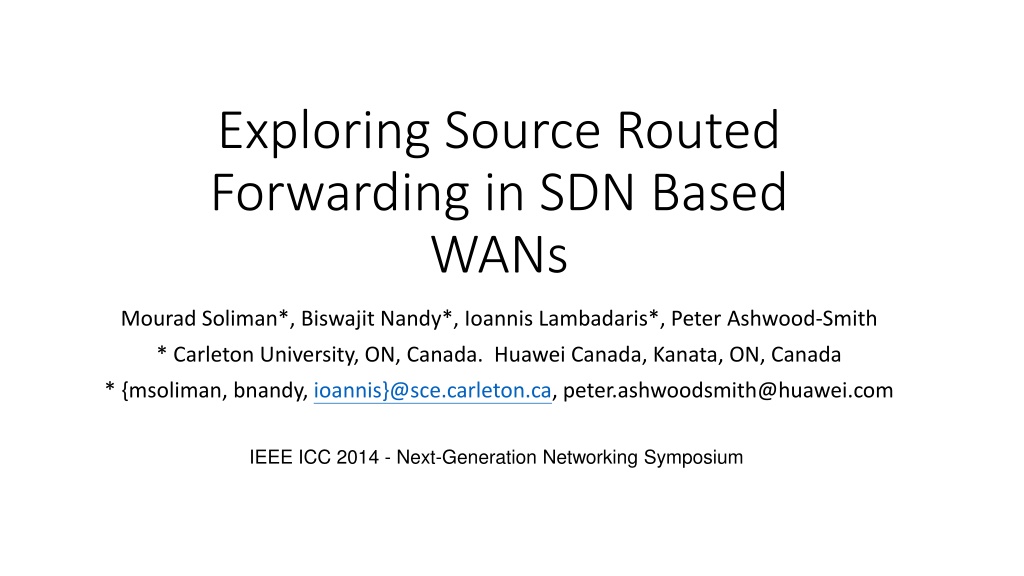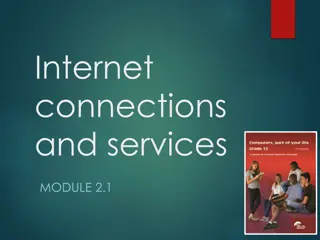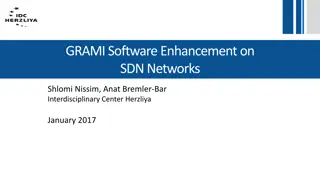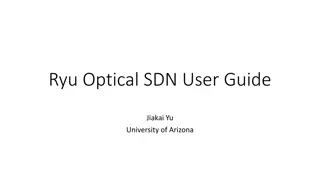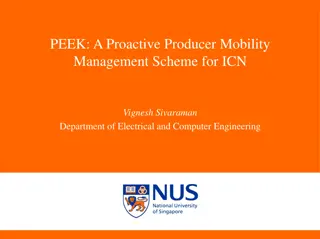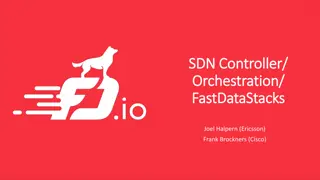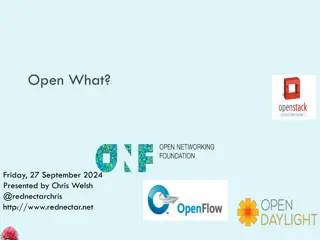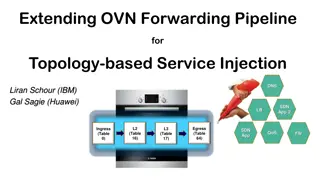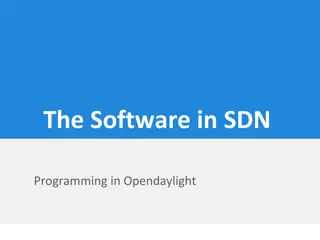Exploring Source-Routed Forwarding in SDN-Based WANs
Software-Defined Networking (SDN) in Wide Area Networks (WANs) utilizes source routing methods to address performance concerns related to network convergence time. Challenges such as latency constraints and controller placement impact performance, highlighting the need for efficient path computations. Related work includes novel source-routed Ethernet protocols like AXON and the use of MPLS labels in SecondNet to create strict source-routed behavior while considering network scalability and security.
Download Presentation

Please find below an Image/Link to download the presentation.
The content on the website is provided AS IS for your information and personal use only. It may not be sold, licensed, or shared on other websites without obtaining consent from the author. Download presentation by click this link. If you encounter any issues during the download, it is possible that the publisher has removed the file from their server.
E N D
Presentation Transcript
Exploring Source Routed Forwarding in SDN Based WANs Mourad Soliman*, Biswajit Nandy*, Ioannis Lambadaris*, Peter Ashwood-Smith * Carleton University, ON, Canada. Huawei Canada, Kanata, ON, Canada * {msoliman, bnandy, ioannis}@sce.carleton.ca, peter.ashwoodsmith@huawei.com IEEE ICC 2014 - Next-Generation Networking Symposium
Introduction Software Defined Networking relies on the separation of control and data planes. Control and data plane to evolve independently SDN raises performance concerns regarding Network convergence time at both flow initiation and failure recovery.
Challenge Reducing the latency in the communication process between the controller and the switches is usually not an option in a WAN : constrained by physics regarding propagation speeds physical topology. Reduces the volume of communication between switches and controllers
Controllers placement impacts performance Performance varies widely with different placement choices only a small percentage of these choices are near optimal
Source routing methods Strict Source Routing requires that every hop be included in the header Loose Source Routing allows for some hop-by-hop behavior mid path centralized SDN-network controller has a global view of the entire network it is capable to perform path computations efficiently thus making source routing a natural fit for SDN architecture
Related Work in Conventional Network AXON [13] proposes a novel source-routed Ethernet protocol Transfer data through a network of source-routing-enabled Ethernet- compatible devices called Axons provides greater performance and scalability than conventional switched Ethernet network architectures
SecondNet: MPLS labels SecondNet [6] introduce the notion that a stack of MPLS labels consumed one by one at each hop Create Strict Source Routed behavior Problem: MPLS labels are large in size; 20 bits, and the stack size upper bounds would limit the diameter of the network Popping labels hides the path the packet has taken so far, makes network troubleshooting even more difficult and reduces security
SDN based source routing Rain Man propose a scalable SDN Datacenter solution that also leverages means of source routing and is compatible with architectures like SecondNet. Segment Routing as alternative source routing based solution to achieve simplicity, better traffic engineering and fast reroute capabilities
Conventional Hop-by-Hop routed Reduced by Source Routed
Source Routed Step (d), takes at least time equal to the maximum RTT between the controller and each of the intermediate Source routing in a WAN eliminates most of step (d) from the flow setup time The path information would be put in the form of a source route and pushed down to the ingress switch only. The source route information will be recorded in the header of every packet in a given flow
Source routed NodeX to NodeY along the highlighted path, a header can be embedded in the packets with the path expressed as the sequence {2,3,3,3} v.s. MPLS Tunnel reverse path calculation and local link failure recovery (Work in progress )
Implementation in SDN OpenFlow-enabled Switches new action type is defined to encapsulate a new header : path- header, Path-headers will hold a sequence of interface numbers that the flow will be forwarded through at each respective intermediate node
Performance Analysis The computational performance analysis is based on modeling a production SDN-based WAN. Internet2 has deployed a 34-node SDN across the US to support advanced scientific research called OS3E [1].
0S3E specification Different sources of network delays were taken into account such as propagation delays, transmission delays and queuing delays. state installation delays are relatively small enough
First step: network convergences time using the optimal controller placement Network convergence time is defined as the total time the first packet of an unknown flow takes from source to destination. Traditional SDN: the time taken by 1. the ingress switch to communicate the unknown flow information to the controller 2. the controller s processing, 3. the controller s state distribution and receiving acknowledgements from intermediate nodes on the selected flow path 4. packet propagation along the selected path. Reduced by Source Routed
Avg. Convergence time average convergence time for all the source nodes in the case of source routing is substantially lower than the case of hop-by-hop routing source routing achieves a 41.7% decrease in the average convergence time compared to hop- by-hop routing Red dot : hop-by-hop Blue dot: source routing
Fraction of flows source routing 92% of the flows have convergence time less than 40ms, against only 55% for hop-by-hop routing A significant improvement in overall network convergence performance that directly affects flow initialization as well as network fault recovery
V.S. Proactive mode network core by installing flow table entries in the core switches explaining how possible flows should be handled ahead of time. Disadvantage: 1. Controller communicates with all the network core elements and installs entries about all the possible flows 2. require storing a large number of entries in the flow tables 3. Change or failure will require redistribution Source routing eliminates the need of the above methods
Step two: Controller Placements Two performance metrics; average and worst case node-to-controller latency 53% reduction in the standard deviation of the average convergence times over all the placements when using source routing Avg. Controller placement
Worst case convergence time As source routing brings a 47% reduction in the standard deviation over all the placements
Source routing Concerns Header Size: 90 bits are sufficient to capture all next hops for the longest path This seems acceptable when compared to IP/Ethernet header or MPLS tunnel header sizes Security: source routing path headers are only added by the ingress switches. Ingress switches would be trusted devices that authenticate with the network controller
Fault Management rapidly adding the alternative source route to the packets at the ingress switch no need for new state redistribution
Future work Modeling the OS3E network in the NS3 simulation platform to obtain results to be compared to the computational analysis outcomes. Link failure recovery techniques source routing can enable local recovery as a quick temporary response to detour the traffic around the failure until the controller responds with new revised state
Conclusion Source routing has been demonstrated to provide significant gains in network convergence time greater flexibility in controller placements Use less flow entries compare to MPLS tunnel But Openflow dosen t support source routing
